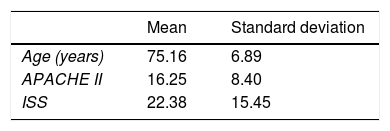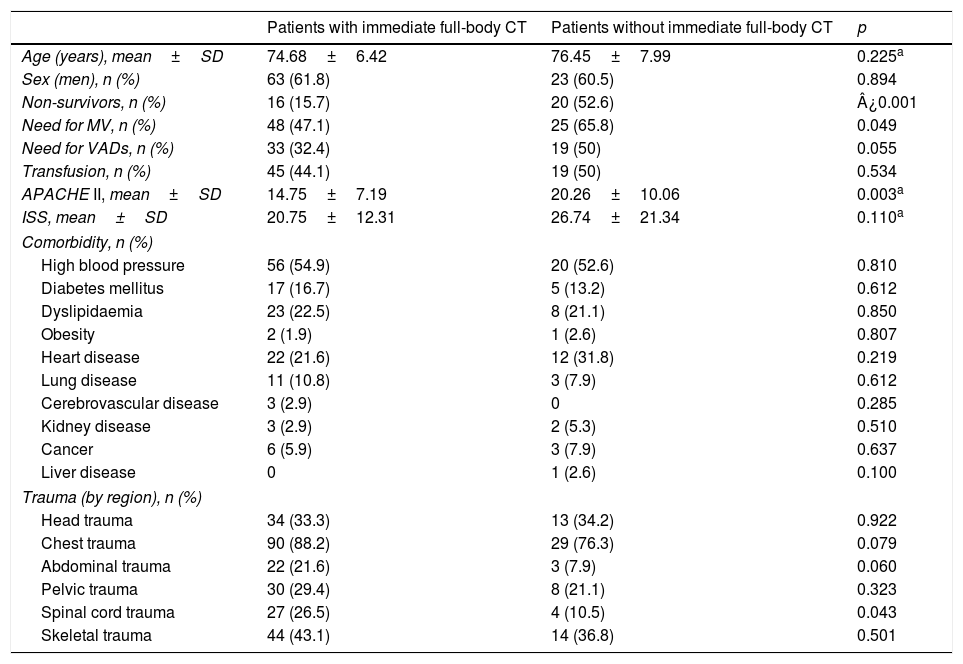To determine the relationship between the use of whole-body computed tomography (WB-CT) and hospital mortality in elderly patients with thoracic–abdominal–pelvic injury requiring admission to an intensive care unit.
Patients and methodAn observational, descriptive and retrospective study was conducted on 140 patients aged 65 years and older admitted to the intensive care unit after a thoracic–abdominal–pelvic injury. Two groups were established, depending on whether a WB-CT was performed as a routine part of the study or the diagnosis was established by conventional radiography or ultrasound. A comparative analysis was performed on both groups, as well as an analysis of mortality through logistic regression.
ResultsThe mean age of the patients was 75.16±8.89 years. The mean score on the APACHE II scale was 16.25±8.4 points, and on the Injury Severity Score scale, 22.38±15.45 points. WB-CT was performed on 102 patients (72.9%). In these patients, there was a lower mortality rate (15.7 vs. 52.6%, p¿0.001), a lower need for mechanical ventilation (47.1 vs. 65.8%, p=0.049), and a lower score on the APACHE II scale (14.75±7.19 vs. 20.26±10.06 points, p=0.003). The multivariate analysis showed a lower mortality in the patients in whom WB-CT was performed, with an OR of 0.21 (95% CI 0.07–0.68; p=0.010), after adjusting for the APACHE II and ISS scores.
ConclusionsPerforming a WB-CT scan as part of the trauma study could improve the management of elderly patients with thoracic–abdominal–pelvic involvement admitted to the intensive care unit.
Analizar la asociación de la realización de una tomografía computarizada (TC) corporal con la mortalidad intrahospitalaria en pacientes de edad avanzada con afectación toracoabdominopélvica que precisa ingreso en una unidad de cuidados intensivos.
Pacientes y métodoEstudio observacional, descriptivo y retrospectivo realizado sobre 140 pacientes con edad igual o mayor de 65 años ingresados en una unidad de cuidados intensivos tras un traumatismo con afectación toracoabdominopélvica. Se establecen 2 grupos, según se haya realizado TC corporal como parte rutinaria del estudio o el diagnóstico se estableciera mediante radiografía convencional o ecografía. Análisis comparativo de ambos grupos y análisis de la mortalidad mediante regresión logística.
ResultadosLa edad media fue de 75,16±8,89 años. La puntuación media en la escala APACHE II fue de 16,25±8,4 puntos, y en la escala Injury Severity Score, de 22,38±15,45 puntos. Se realizó TC corporal en 102 pacientes (72,9%). En estos se observó una menor mortalidad (15,7 frente a 52,6%; p¿0,001), una menor necesidad de ventilación mecánica (47,1 frente a 65,8%; p=0,049) y una menor puntuación en la escala APACHE II (14,75±7,19 frente a 20,26±10,06 puntos; p=0,003). El análisis multivariante mostró una menor mortalidad en los pacientes en los que se realizó TC corporal, con una OR de 0,21 (IC 95% 0,07–0,68; p=0,010), tras ajustar por puntuación en la escala APACHE II y en el Injury Severity Score.
ConclusionesLa realización de TC corporal como parte del estudio del traumatismo podría mejorar el manejo de los pacientes de edad avanzada con afectación toracoabdominopélvica que ingresan en una unidad de cuidados intensivos.









